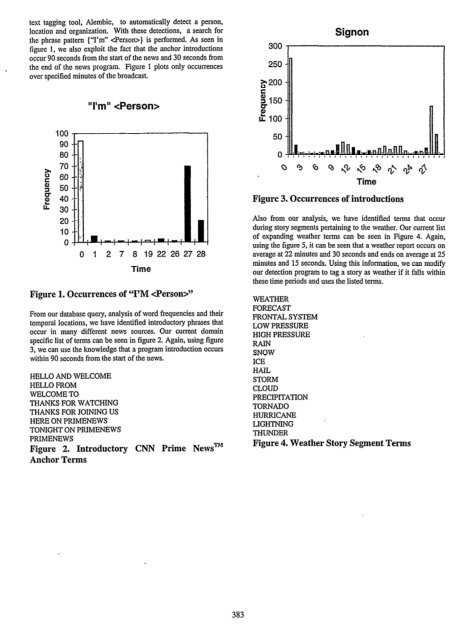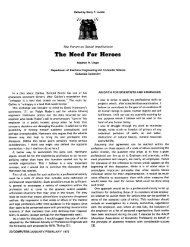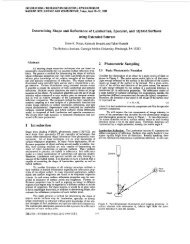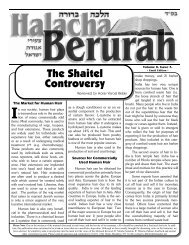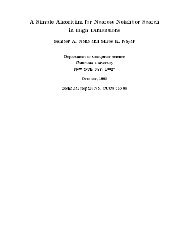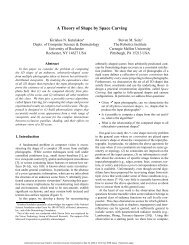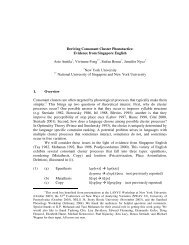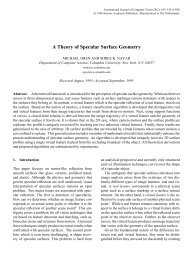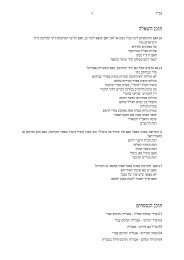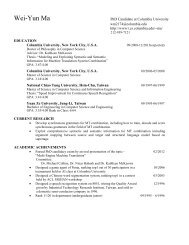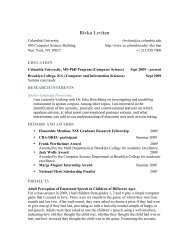Broadcast News Navigation using Story Segmentation
Broadcast News Navigation using Story Segmentation
Broadcast News Navigation using Story Segmentation
You also want an ePaper? Increase the reach of your titles
YUMPU automatically turns print PDFs into web optimized ePapers that Google loves.
text tagging tool, Alembic, to automatically detect a person,<br />
location and organization. With these detections, a search for<br />
the phrase pattern (“I’m” } is performed. As seen in<br />
figure 1, we also exploit the fact that the anchor introductions<br />
occur 90 seconds from the start of the news and 30 seconds from<br />
the end of the news program. Figure 1 plots only occurrences<br />
over specified minutes of the broadcast.<br />
90 ---<br />
80 --<br />
~ 70 --:<br />
2 60--;<br />
g 50 -4<br />
t<br />
iit-<br />
40 --<br />
30 -- :<br />
20 -- :’<br />
IO --<br />
“I’m” <br />
0-*‘I:-:-:-:“:‘:. : I<br />
0 1 2 7 8 1922262728<br />
Time<br />
Figure 1. Occurrences of “I’M ”<br />
From our database query, analysis of word frequencies and their<br />
temporal locations, we have identified introductory phrases that<br />
occur in many different news sources. Our current domain<br />
specific list of terms can be seen in figure 2. Again, <strong>using</strong> figure<br />
3, we can use the knowledge that a program introduction occurs<br />
within 90 seconds from the start of the news.<br />
HELLO AND WELCOME<br />
HELLO FROM<br />
WELCOME TO<br />
THANKS FOR WATCHING<br />
THANKS FOR JOINING US<br />
HERE ON PRIMENEWS<br />
TONIGHT ON PRIMENEWS<br />
PRIMENEWS<br />
Figure 2. Introductory CNN Prime <strong>News</strong>TM<br />
Anchor Terms<br />
383<br />
3oo I<br />
250<br />
2200<br />
5<br />
3 150<br />
$<br />
t 100<br />
50<br />
Signon<br />
0 . ..a..*.. I I I t , I<br />
Figure 3. Occurrences of introductions<br />
Also from our analysis, we have identified terms that occur<br />
during story segments pertaining to the weather. Our current list<br />
of expanding weather terms can be seen in Figure 4. Again,<br />
<strong>using</strong> the figure 5, it can be seen that a weather report occurs on<br />
average at 22 minutes and 30 seconds and ends on average at 25<br />
minutes and 15 seconds. Using this information, we can modify<br />
our detection program to tag a story as weather if it falls within<br />
these time periods and uses the listed terms.<br />
WEATHER<br />
FORECAST<br />
FRONTAL SYSTEM<br />
LOW PRESSURE<br />
HIGH PRESSURE<br />
SNOW<br />
ICE<br />
STORM<br />
CLOUD<br />
PRECIPITATION<br />
TORNADO<br />
HURRICANE<br />
LIGHTNING<br />
THUNDER<br />
Figure 4. Weather <strong>Story</strong> Segment Terms


